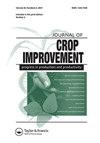Chitosan mitigates the adverse effects and improves photosynthetic activity in rice (Oryza sativa L.) seedlings under drought condition
IF 1.5
Q3 AGRONOMY
引用次数: 10
Abstract
ABSTRACT The ability of chitosan to promote rice growth, physiological traits, and photosynthetic performance in rice seedlings under drought stress was investigated. Rice seedlings (Oryza sativa L. cv. KDML105) were treated with 100 mg l−1 low and high molecular weight (MW) chitosan via a combination of seed priming and foliar spray. The seedlings were subjected to drought stress by withholding water for 4 days, which resulted in the U-shaped (scale 5) leaf rolling. The results showed that drought significantly decreased shoot and root growth. Chitosan application, particularly with high MW chitosan, improved shoot and root growth under drought stress. Chitosan treatment also alleviated the effects of drought stress by elevating relative water content, as well as reducing electrolyte leakage and malondialdehyde content. Antioxidant enzyme activities, including guaiacol peroxidase (GPX) and ascorbate peroxidase (APX), were increased in response to chitosan. Additionally, treating the plant with chitosan improved photosynthetic efficiency as evidenced by increased CO2 response, the maximum rate of Rubisco carboxylase activity (Vcmax), and photosynthetic rate. We conclude that the exogenous application of chitosan aids the plant in coping with the severity of drought stress. While both low and high MW chitosans were effective at alleviating the effect of drought on rice seedlings, high MW chitosan might have a slight advantage with respect to increased effective duration.壳聚糖减轻了干旱条件下水稻幼苗的不利影响,提高了幼苗的光合活性
摘要研究了壳聚糖对干旱胁迫下水稻幼苗生长、生理性状和光合性能的影响。水稻幼苗(Oryza sativa L. cv.)以100 mg l−1低分子量和高分子量壳聚糖(MW)为处理剂,通过种子引种和叶面喷雾相结合的方式处理KDML105。幼苗在干旱胁迫下,连续4天不浇水,叶片呈“u”型(5型)卷曲。结果表明,干旱显著降低了地上部和根部的生长。施用壳聚糖,特别是高分子量壳聚糖对干旱胁迫下茎、根生长有改善作用。壳聚糖处理还可以通过提高相对含水量、降低电解质泄漏和丙二醛含量来缓解干旱胁迫的影响。壳聚糖增加了愈创木酚过氧化物酶(GPX)和抗坏血酸过氧化物酶(APX)的活性。此外,壳聚糖提高了植株的光合效率,提高了CO2响应、Rubisco羧化酶活性最大值(Vcmax)和光合速率。我们认为外源施用壳聚糖有助于植物应对严重的干旱胁迫。低分子量壳聚糖和高分子量壳聚糖均能有效缓解干旱对水稻幼苗的影响,而高分子量壳聚糖在延长干旱持续时间方面可能略有优势。
本文章由计算机程序翻译,如有差异,请以英文原文为准。
求助全文
约1分钟内获得全文
求助全文
来源期刊

Journal of Crop Improvement
Multiple-
CiteScore
3.30
自引率
7.70%
发文量
42
期刊介绍:
Journal of Crop Science and Biotechnology (JCSB) is a peer-reviewed international journal published four times a year. JCSB publishes novel and advanced original research articles on topics related to the production science of field crops and resource plants, including cropping systems, sustainable agriculture, environmental change, post-harvest management, biodiversity, crop improvement, and recent advances in physiology and molecular biology. Also covered are related subjects in a wide range of sciences such as the ecological and physiological aspects of crop production and genetic, breeding, and biotechnological approaches for crop improvement.
 求助内容:
求助内容: 应助结果提醒方式:
应助结果提醒方式:


